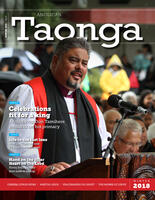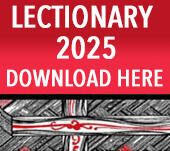For the Anglican Church Hermeneutical Hui, 29 June 2010.
Introduction
As a one-time Brethren boy I can think of no greater privilege than to study the scriptures with others and so I’m delighted to delighted to be studying the scriptures with Anglicans. I’d always hoped for an invitation like this!
But needless to say I am a little nervous! You need to understand that I am just myself. I am gay and I am Christian, but I am neither representative gay nor (as I’m sure some of you will be the first to agree) representative Christian.
And I am not a biblical scholar although I do have a BD from Otago with a New Testament major. I just wish that I had kept up my Hebrew!. But the field in which I work regularly is in history, and in many ways historians develop arguments in quite different ways than theologians in general. Still I am a scholar. I am well aware that there are different interpretations, and in the discussion we add and develop new understandings. So personally I will revel in the new ideas and approaches which will come here. And I will struggle and wrestle with them, because I think that new understandings of scripture are an invitation to discovery and to obedience.
Queer Readings
I am not a great fan of queer readings. They are part of a trend in literary criticism– feminist, black, Maori, and queer readings – (whether in scripture or in other literature) which seems to have no easy ‘control’ mechanism. They are often a form of special pleading. I don’t think we should ever want to play down the force of the text and to be well aware of the two horizons of the text as originally heard and the text as we hear it.
When it comes to scripture, there is a particular problem, unless we are clear on what the goal of these readings is. They are flawed if they designed to evade the force of a passage to us. So the only credibility of readings is if we work as hard on the text as it was first read in the process of determining how we hear it now.
And yet, it surely is the case that we hear the scriptures on the basis of our own background. It can be easily shown that passages of scripture have a different force in different contexts. I know that sometimes it can be used to evade the meaning of scripture, but I want it to tune the words of scripture so that it can speak to me clearly. The process can be very painful as feminist explorations have shown. We may have to decide what we do with the outrageous parts, and how we treat in particular parts of the Old Testament. The risk is that we also highlight certain meanings and evade others. Ben Lieuw, a significant friend of queer readings, has warned the gay community that gay people with their sense of outrage for themselves there must be careful not to forget other critical issues like ethnicity poverty and gender difference.[1] It is an important point but not one which cancels the value of an acute listening to Scripture for ourselves.
The Use of Sodomy
And it seems to me that in the case of Sodom, a Queer Reading is altogether justified, because of the abuse associated with it. The popular use of this text bears little relationship to the text as it was originally heard. I was terribly dubious about this hui beginning with Sodom, which seemed to me so beside the point. But now I see that exploring the mis-hearing of the Sodom story is essential if we are to move on. Although it has been recognised by almost all commentators that this is not an anti-homosexual text, yet this interpretation persists in our culture. I think we could call it the hetero-normal reading of the text invented to strengthen abhorrence of gay people at a critical point in western history. The shocking thing to me is what this invention of Sodom has done. It has become Christendom’s justification of its desire that gay people be removed.[2] Sodom still today is used as a short-hand for everything that is revolting about the homosexual people, and their threat to good people and society. It has fed a deep fear in our society of gay people and their threat. It has led to predictions of doom for gay people who deserve to be destroyed by God whether by volcanic activity or by the AIDS virus. This coined word which became the standard word for the male homosexual provided reasons why homosexual activity was not simply one sin among others, but something peculiarly and unspeakably vile.
Now when scripture is used savagely to destroy people’s identity and values and to create in them a complete conflict between their identity and their faith, then the damage to Christian ministry and evangelism is massive. I know from the work I am constantly engaged in holding bible studies and outreach for gay people along with by brothers and sisters at Auckland Community Church. Again and again we confront the combination of the discovery of sexual identity and the denial of faith. Stephen Moore reacts to words scrawled on a lavatory door in San Ysido:
(God) does hate queers; it's true. But why? … It's because He has been saddled with a brittle masculinity that shores up its fragile identity by violently obliterating femininity, even, or especially, the woman (who cowers) within - … His will to power, to overpower, to become (a) man. Hence the necessity of the incarnation. What might Paul himself have said? Or rather what might the culture that produced Paul .. and through Paul this epochal epistle whose extraordinary Wirkungsgeschichte now includes a homophobic scrawl on a lavatory door..[3]
The Sin of Sodom
It was D.S. Bailey who in 1955 challenged standard views of the interpretation of Sodom as an anti-homosexual text. Looking back one may see that Bailey overstated his case. His arguments have rightly been severely challenged over the last 55 years. Firstly he argued that ‘yadha’ “to know” in the text might not mean sexual knowledge.[4] He secondly queried the character of the sin of Sodom for which Sodom was judged. His suggestions filled out by others have led to various interpretations of Sodom.
The Sin of Inhospitality
Bailey’s interpretation was taken up and developed by the historian John Boswell. He particularly developed the theme that the sin of Sodom was in fact a sin against the responsibility of hospitality.[5] The way these angelic visitors are treated profoundly offends against the ancient world’s view of the treatment of the stranger. To this end Ezekiel 16: 49-50 may be cited. And look at the context in which Jesus cites the story. In Matthew 10:14-15 and in Luke 10:10-12 we are told that those who do not receive the visiting disciples will be more guilty than the people of Sodom.
There is something attractive in the ‘hospitality’ theme and it can’t be completely wrong because of the parallel with Genesis 18 where his profound hospitality led to great blessing for Abraham. There is a Jewish story about Palit, a rebellious daughter who feeds a beggar in the streets of Sodom and feeds hi,/ And for this she is sentenced to death and chants the words of Psalm 9:4 pleading to God to maintain her cause. It is this which brings God down to Sodom.[6]
However one should sent the hospitality theme in context. One may perceive the profound gulf between Abraham and the peoples of the land he has come to. He will not settle in the cities on the plain. Lot does settle there, but Lot’s relationship with the people of Sodom is clearly tense. Lot’s reluctance to leave the city while the Sodomites do not return this affection is significant. The chapter ends with Lot’s search for a little city where he can settle nearby, his wife’s look back, the pollution of Lot and his daughters that leads to the commencement of Moab and Ammon are all profoundly symbolic. I do wonder whether offensive attitude to divine beings is part of the issue which accentuates the faults of Sodom. This is their unrighteousness seen is all its clarity. Jews since have generally seen the sin of Sodom as xenophobia, not homosexuality.
So certainly here is a significant revelation of the real sin of Sodom, and one which the modern church might certainly take to mind. Have not gay people a right to be distressed that the very passage that talks of a sin of inhospitality is used to reinforce inhospitality to them?
Sodom and Sexual Violence
But the Old Testament passages that accuse Sodom of the sin of inhospitality do not stop there. For example Ezekiel 16:49-50 and the surrounding verses go well beyond this. Verse 50 talks of abomination. Pride and refusal to aid for poor and needy is also cited by Ezekiel. Other biblical references include Isaiah 1:10; Isaiah 3:9, and Jeremiah 23:14. These identify a broad range of issues. In the Hebrew Old Testament the sin of Sodom is largely identified as its general violence. In the deuteron-canonical Greek books, other factors are cited. Ecclesiasticus 16:8 and Wisdom 19:13-14 cite pride and other evils.
References in the New Testament identify the sin as porneia. Jude 1:7 and 2 Peter 2:6-10 refer are particularly significant. And porneia is a broad an inclusive term which certainly does not focus specifically on homosexual behaviour.
The Puzzle of the Reputation of Sodom
But what is lacking in almost all Jewish references – even, I think in 2 Peter and Jude - is any reference to homosexuality as the sin of Sodom. So where did this interpretation come from? Scholars since Bailey wrote have widened the net tp understand this, for Christian interpreters sharply diverge from Jewish interpreters who consistently avoid the homosexual explanation of the sin of Sodom. Yet one may see hints of this interpretation from very early on. There seems to be some trend in this direction in Josephus in the late first century. Then there are some hints of a sexual interpretations in the pseudopgraphica particularly the book of Enoch. These pseudopigraphica seem to have influenced 2 Peter and Jude.
Philo does approach a homophobic interpretation. Josephus has quite a lot of detail but does not emphasise a homoerotic interpretation. (Antiquities 1.198-199).[7]
Now when one explores early Christian opinion it is very mixed. Michael Carden has done the most through exploration of the literature. Tertullian sees it as sexual desire but views all sexual desire as a problem including heterosexual. Basil speaks against homosexuality and associates it with homosexuality, although he particularly emphasises gluttony.[8] Justinian in a decree of 544 seems to emphasise a homosexual interpretation of the sin of sodomy.[9] Chrysostom praises Lot for offering his daughters to protect the men, and interpretations of the passage do reflect the deep misogyny of the early Christian era. Gregory the Great emphasises sexual desires out of control as the problem. Augustine identifies same sex desire as a factor.
However, it is only in the eleventh century that the interpretation fully emerged, as the word ‘sodomy’ was coined in that century.[10] The eleventh century writers see the story in only one way. The writing of Peter Damian is most explicit, in his Book of Gomorrah. Thomas Aquinas inevitably weighed in to call same sex desire unnatural. Why did this happen? Boswell believes that changing views of nature and fear of the rival religions which threatened Christian Europe in this period were a critical factor. The focus of the scholarly condemnation was sodomy among clergy whose celibacy had been newly required by the Gregorian reform movement. The notion of ‘natural’ in Thomistic theology was perhaps bound to be used in this way. Interpretations need to explore why Muslims took the same view.
The Gibeah Clue
I think there is one more crucial dimension which shows up in the parallel of Judges 19. For the outrage of Gibeah is the actions of the crowd when the Levite and the concubine are caught in the square at Gibeah. They want the Levite but are given the concubine and abuse her. So it is a nightmare misogynist world. It is a potential pack rape of a man which is diverted by that same man into a pack rape of woman. And the tale ends a little like Sodom too.
To my mind this passage gives us a key to the horror of the situation. For here again the men start with a request for sex with the male and this time their attention is diverted to a woman. Why would men who want sex with men be mollified with sex with women? What occurs is a pack rape of the concubine. Gibeah shows that this is not sex for pleasure, it is sex as violence. It is an offence which is so horrific that it leads to a whole community act of revenge.
There are very few references to Gibeah in the rest of the Bible. Does this suggest that the men of Sodom were worse because they aimed to abuse men? Or was it a particular shame that from within the heart of Israel came such horrors?
Clues from Leviticus
If sexual violence is the heart of the offence then this Sodom may help us to understand other aspects of sexuality in the Old Testament. We are forced to think through the interpretation of Leviticus in order to find the full meaning of Sodom. The Penteteuch as a whole is bound to need to be read as a whole on these issues. And at the heart of the story lies the serious issue of rape.
In Leviticus 18 and 20 “lying with a man as one lies with a woman” seems to refer to anal sex. It was this aspect of homosexuality which caused particular disgust. But we also need to engage with the reasons behind the text if we want to interpret it correctly. Ed Countryman’s book Dirt, Greed & Sex offers a significant tool for making sense of this. He suggests that the Old Testament legal texts are best explained by reference to two organising themes, the quest for cleanliness and the quest for family property. These can clearly be illustrated in the Old Testament stories including Genesis 19. Countryman has on this basis speculated that notions of filth and greed were evident when a male penetrated another male.[11] They could hardly imagine the concept of consensual sex. So they consistently saw homosexual anal sex as profoundly humiliating for the people who were penetrated.
The rape of a man was seen as far worse than the rape of a woman because it abused the body. It was humiliation and emasculation. On the other hand the penetrator was not defiled by the process. Lot’s horror at the proposal by the men of Sodom shows that in his eyes even the rape of virgin daughters is less demeaning than the rape of the strangers. This is a very significant factor. Now the Greek lying behind 1 Corinthians 6:19-20 (arsenikoitoi) with its reference to the men bedders indicates hat it is based on the ideas of Leviticus 18 and 20.
Perhaps a further factor is the monogenesis theory seemingly held by ancient Jews for this viewpoint holds that only men hold sperm so therefore anything that wastes sperm on other than procreation is wrong. Women had no part in it, so therefore women are not capable as such of sexual (in the sense of procreative) acts.
We should remember the end of the Sodom narrative, the appalling behaviour which is used to blacken the origins of the Moabites and the Ammonites. Lot had been prepared to sacrifice these daughters, and now, perhaps assuming that they are the only ones left in the world after the cataclysm, they abuse their father in order to become pregnant. Now the shaming surely reaches new heights. It isn’t a remotely righteous world even for those who survive the holocaust. Lot is clearly saved only on the basis of the pleas of Abraham, not for anything in himself.[12]
Sexual Violence
I think this is hugely significant that it was only the person who was penetrated, not the penetrator who was shamed by homosexual rape. The writer of Genesis was particularly horrified by homosexual rape. Actually our culture share something of this view. Think of the popular imprecation, “F**k you!” Why is this so common? Surely because our culture still employs sexual shaming at least in words.
But it can be more than that. On 17 October 2001 Andrew James Castles and six other 17-year-old Taradale High School students sexually violated a fellow student with a broom handle at a keg party. Two years later they were tried and found guilty and sentenced to 2-3 years of prison. Justice Gendall described the act as “group thuggery ... mob hysteria... senseless macho male behaviour”. During sentencing, Gendall told the six that they had not only physically harmed the victim but had ruptured his soul and spirit and left him with emotional scars that will take many years to heal.”[13]
The logic of this is clear. Male rape is typically an action of homophobia, not of homosexuals. It is a shaming device. Carden argues that it relieves the sense of sexual panic. So on this logic, the men of Sodom were the exact opposite of homosexual, they were seeking to impugn their victims but in their sick society that was acceptable behaviour. And I fear that we haven’t progress much beyond that.
Social Construction of Sexuality
Ideas of sexuality and particularly of “normality” in the sexual area are clearly socially constructed. Same-sex desire can be a source of shame and horror or joy and fulfilment. It will very much depend on social attitudes. Consider how different in the past was society’s treatment of gay men from that of lesbian women, because women did not engage in anal sex.[14]
Patterns of sexuality and of relationships have now changed markedly. Modern ideas of homosexuality are a consequence of modern ideas of marriage. For if marriage is companionate and by choice, then inevitably some men and some women wanted to acknowledge their love for people of the same gender and move beyond casual sexual acts to relationships.
For gay people there is often talk of the six texts of terror in Scripture. Clearly we cannot easily reconcile homosexual behaviour with the two texts of the Old Testament. Because Greek society found room for a form of pederasty the New Testament is also hesitant. So gay people are another group alongside women, blacks and slaves, who have a problem with the text of the Old Testament. We need to learn from the approach of those who struggled for the liberation of women and of slaves to set the text in context and to appeal outside of the letter to the deeper principles of the law, especially when we realise that we live in the age of the New Covenant.[15]
Conclusion
And so I come back to Sodom. That kind of sexual violence is still abroad in our over-sexualised world. I really don’t understand why we can’t all work together to fight it. I believe that we need with one voice to denounce the myth of Sodom. The gay, lesbian, bisexual and transgendered community is often much more rough and less respectable than the mainstream heterosexual community (although the actual behaviour may be no different). Nevertheless, a search for God is going on right in this place. If we are going to reach my community with the gospel then you will have to realise that this text creates the fear which leads to the sodomising of gay people.
I wonder why we couldn’t instead talk of the story of David and Jonathan, the same-sex lovers. I am not saying that they were secretly engaged in homosexual acts; the text doesn’t and couldn’t say this. But it did speak of the beauty of this relationship and thus opened up rich insights on the value and goodness of this which it celebrated alongside all the goodness and love of married heterosexual relationships. This is so much better a place to start than with the mis-exegesis of Genesis 19.
Peter Lineham
Massey University Albany Campus
27 June 2010.
NOTES
[1] Lieuw in Queer Commentary and the Hebrew Bible, ed. Ken Stone, Sheffield Academic Press, 2001, (JSOT Supplement Series 334) p. 187.
[2] Eve Sedgewick cited by M Carden in Queer Commentary, p. 154.
[3] Stephen D. Moore, God’s Beauty Parlor and other Queer Spaces in and Around the Bible, Stanford University Press, 2001, p. 202.
[4] Derrick Sherwin Bailey, Homosexuality and the Western Christian Tradition, London: Longmans Green, 1995 Archon reprint 1975, pp. 2-5.
[5] John Boswell, Christianity, Social Tolerance and Homosexuality, Gay People in Western Europe from the Beginning of the Christian Era to the Fourteenth Century, University of Chicago Press, 1980, pp. 92-97.
[6] Carden in Queer Commentary, p. 156.
[7] Incidentally, Whiston’s translation has been deeply influenced by later interpretations, so uses the term sodomy. See Michael Carden, Sodomy” A History of a Christian Biblical Myth, London: Equinox, 2004, pp. 73-76.
[8] Carden, Sodomy, p, 134.
[9] Carden Sodomy, p 126 citing Bailey.
[10] For detail see Mark D Jordan, The Invention of Sodomy in Christian Tradition University of Chicago Press, 1996.
[11] L. William Countryman, Dirt, Greed & Sex: Sexual Ethics in the New Testament and their Implications for Today, revised edition, Minneapolis: Fortress Press, 2007, pp. 17-45.
[12] See for this the Queer Bible Commentary ed. Deryn Guest, Robert E. Goss, Mona West and Thomas Bohache, London: SCM Press, 2006, pp. 38-39.
[13] Dominion Post, 2 April 2003 and 24 May 2003 on the Stuff website, accessed 24 April 2010.
[14] See the very interesting interpretation of Romans in Tobias Stanislaus Haller, Reasonable and Holy: Engaging Same-Sexuality, New York: Seabury Books, 2009, pp 62-68.
[15] W.M. Swartley, Slavery, Sabbath, War and Women: Case Issues in Biblical Interpretation (Herald Press, 1983). See also William J. Webb, Slaves, Women and Homosexuals: Exploring the Hermeneutics of Cultural Analysis (Downers Grove: Inter-Varsity Press, 2007), and its search for a redemptive movement hermeneutic - although unlike Webb I think it can be applied as well to homosexuals.

















Comments
Log in or create a user account to comment.